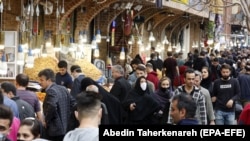In his recent message addressing Iranians Reza Pahlavi, the increasingly popular crown prince of Iran, drew a clear line between the “Islamic Republic” and “Iran” and asked the nation, “on which side do you stand?” He continued, “In order to save Iran, what are you willing to do?”
These simple questions keep repeating in my head as I see 40 years of tyranny, corruption and oppression flash again before my eyes. A violent revolution born on the basis of exclusion, omission and elimination of all political groups, and discrimination towards all religious and ethnic minorities was set to change the cultural values of one of the most ancient and peaceful nations in the world.
The 1979 Islamic Revolution in Iran and the establishment of the totalitarian regime that followed, was the beginning of a nightmare that has held a death grip on the Middle East to this day. Islam as a faith was turned into a radicalized political force in the hands of extremists who now controlled vast resources and assets of a very rich country. Guided by half-baked Islamo-Marxist theories, the new Islamic Don Quixotes saw progress as their archenemy and set out to destroy anything and everything that stood in the way of their apocalyptic campaign.
Today, as a result, 80 million Iranians are held hostage by an occupying regime. 600,000 Syrians have been slaughtered. The people of Yemen, Iraq, Lebanon, Afghanistan have been besieged by non-stop killing. Millions have been forced to seek refuge in tenements across the region and across Europe. Terror groups inspired by the Islamic Republic’s effective blend of violence and ideology hold the region and the world for ransom.
For too long, political leaders in the West have looked for quick bandages to solve the problem. They have sought to appease the regime. They have sought to empower “moderates” who, to Iranians, are part of the same Cosa Nostra as the IRGC leaders who slaughter people in our streets. They have sought to turn the regime into a “normal” government. They have failed. Western political leaders must, as Iranians have, decide that this regime cannot be dealt with. There must be an alternative. It is here where the “New Covenant” focuses.
In his speech, Mr. Pahlavi makes a clear distinction between the Islamic Republic and Iran. The undemocratic nature of the regime in which people have zero influence in decision making has made it clear that this regime does not represent Iranians, and because of their religious, non-Iranian ambitions the mullahs do not even represent the name of Iran. The New Covenant suggests to Iranians, but also to the West, that the only alternative is the democratic rule of the Iranian people.
Since the announcement of this New Covenant, which dominated Iranian media and social media in the days before and after its release, Iranians seem to have turned a page. Opposition groups are coalescing, individual Iranians are thinking of ways to take on their civic responsibility. The nation seems to have accepted this New Covenant, and together they are working on ways to put it into action.
In contrast to the violent, exclusionary revolution of 1979 which focused on the elimination of opponents and discrimination against all who did not fit a strict profile of “purity” the New Covenant is leading Iran in the direction of inclusion, peace, tolerance. These values are the ones that give it the greatest chance to lead to sustainable, positive change.
The question many Iranians- who know where they stand in the duality between Iran and the Islamic Republic- however ask, is where does the West stand? Where do all the politicians who represent the “free world” stand in this struggle for freedom? How do they not see that a stable, democratic and secular Iran can become a beacon of hope and a role model for other nations in the region and become a progressive, cooperative member of the international community? The question many Iranians ask is how much atrocity, violence and tyranny can the West witness before they take a stand and choose the side of the people?
Iranians, in spite of what Western-based apologists for the regime and politicians who flirt with the Islamic Republic say, are demanding support for their movement. They do not want war, but they do not want the West to take the side of tyranny when they are fighting for liberty.
In a country with a long history of one-man rule, Iranians are rallying around this New Covenant which says that the country can only be saved when each Iranian plays a role. To save their country, to fight for justice, they are willing to step up. They know where they stand. But they are asking the West: where do you stand? On the side of the Islamic Republic or the side of Iran?






